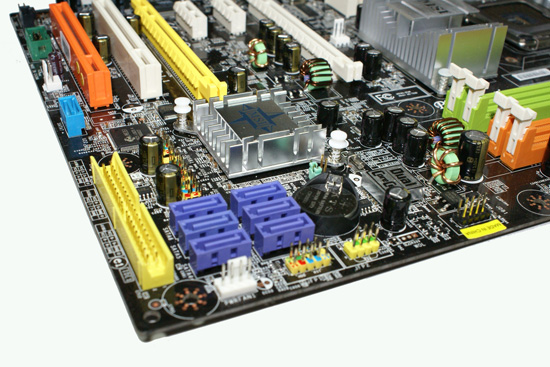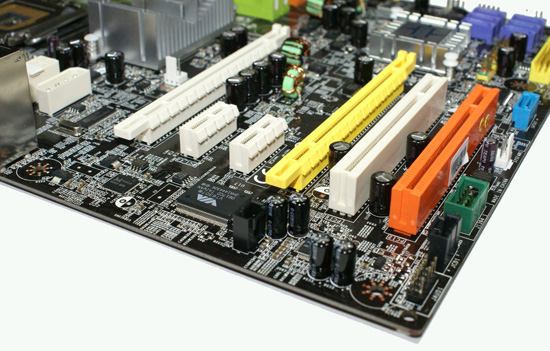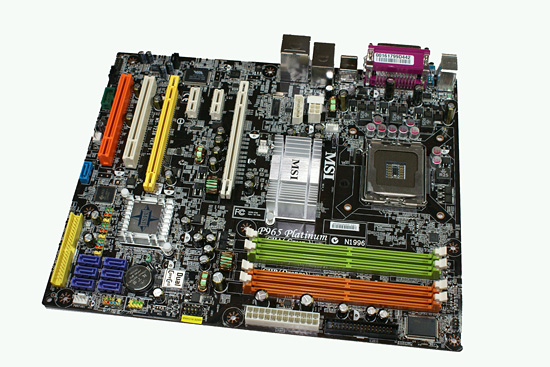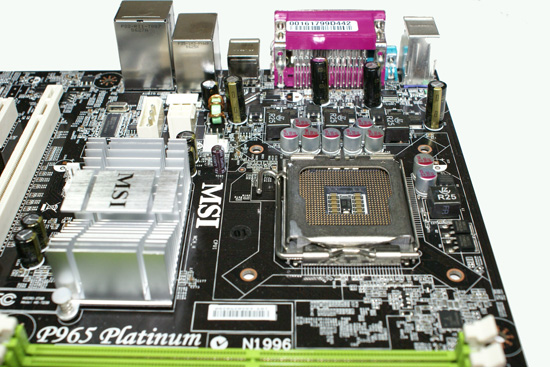Intel P965: MSI P965 Platinum and ECS PX1 Extreme
by Gary Key on December 6, 2006 4:30 AM EST- Posted in
- Motherboards
MSI P965 Platinum: Board Layout and Features
The P965 Platinum board has an excellent layout for the most part, the color combination is pleasing to the eyes, and it was extremely easy to install in our Cooler Master CM Stacker 830. However our concern is the location of the 8-pin ATX and 4-pin Molex power connectors near the CPU area, as they could cause cable management issues with larger air coolers like the Scythe Infinity. We also recommend installing the 8-pin ATX connector first if you plan to install a large air cooling system. The board features a total of four fan headers and a four-phase voltage regulator system that provided superb stability throughout our standard testing.

The DIMM module slots' color coordination is not correct for dual-channel setup based upon the premise of installing DIMMs in the same colored slots for dual-channel operation. Thus, you will want to install DIMMs in different colored slots. The color coordination is a minor point, however, and is at least partially outweighed by the fact that it is very easy to install memory modules with a full size video card placed in the first PCI Express x16 slot. The 24-pin ATX connector and floppy drive connector are conveniently placed along the bottom edge of the board underneath the memory slots.

The six Intel ICH8R SATA ports are blue and are located to the left of the battery and above the second fan header. The SATA ports feature the newer clamp and latch design. We found the positioning of the SATA ports to be very good when utilizing the PCI 2.3 slots but you will lose SATA ports 3 and 6 when utilizing a double slot video card in the second x16 physical slot. The single IDE connector is located on the lower far left edge of the board, which isn't the best location for the majority of people that will use an IDE optical drive located in one of the upper 5.25" bays. The ICH8R is passively cooled and remained cool to the touch throughout testing. The chassis panel is located below the SATA ports.

The board comes with two physical PCI Express x16 connectors (x16 and x4 electrical), two PCI Express x1 connectors, and two PCI 2.3 connectors. The layout of this design offers one of the better dual x16 connector designs we have worked with as you will only lose a single x1 PCI-E and PCI slot when operating with two dual slot video cards. You can also see the third fan header and the JMicron SATA port located next to the last PCI slot, and the fourth fan header is located next to the first x16 PCI Express connector.
Getting back to CPU socket area, we find a fair amount of room for alternative cooling solutions. We utilized the stock heatsink/fan in our normal testing but also verified a few larger Socket 775 air cooling solutions would fit in this area during our overclocking tests. The Intel P965 MCH chipset is passively cooled with a mid-rise heatsink unit that did not interfere with any installed peripherals. The 4-pin Molex connector is required when utilizing dual graphics cards.

The rear panel contains the PS/2 mouse and keyboard ports, LAN port, serial, Firewire, and parallel ports along with four USB 2.0 ports. The LAN (RJ-45) port has two LED indicators representing Activity and Speed of the connection through the Realtek RTL8111B Gigabit PCI-E chipset. The audio panel consists of six ports that can be configured for 2, 4, 6, and 8-channel audio connections for the Realtek ALC883 HD codec. The panel also includes S/PDIF optical and coaxial out ports.
 |
| Click to enlarge |
The P965 Platinum board has an excellent layout for the most part, the color combination is pleasing to the eyes, and it was extremely easy to install in our Cooler Master CM Stacker 830. However our concern is the location of the 8-pin ATX and 4-pin Molex power connectors near the CPU area, as they could cause cable management issues with larger air coolers like the Scythe Infinity. We also recommend installing the 8-pin ATX connector first if you plan to install a large air cooling system. The board features a total of four fan headers and a four-phase voltage regulator system that provided superb stability throughout our standard testing.

The DIMM module slots' color coordination is not correct for dual-channel setup based upon the premise of installing DIMMs in the same colored slots for dual-channel operation. Thus, you will want to install DIMMs in different colored slots. The color coordination is a minor point, however, and is at least partially outweighed by the fact that it is very easy to install memory modules with a full size video card placed in the first PCI Express x16 slot. The 24-pin ATX connector and floppy drive connector are conveniently placed along the bottom edge of the board underneath the memory slots.

The six Intel ICH8R SATA ports are blue and are located to the left of the battery and above the second fan header. The SATA ports feature the newer clamp and latch design. We found the positioning of the SATA ports to be very good when utilizing the PCI 2.3 slots but you will lose SATA ports 3 and 6 when utilizing a double slot video card in the second x16 physical slot. The single IDE connector is located on the lower far left edge of the board, which isn't the best location for the majority of people that will use an IDE optical drive located in one of the upper 5.25" bays. The ICH8R is passively cooled and remained cool to the touch throughout testing. The chassis panel is located below the SATA ports.

The board comes with two physical PCI Express x16 connectors (x16 and x4 electrical), two PCI Express x1 connectors, and two PCI 2.3 connectors. The layout of this design offers one of the better dual x16 connector designs we have worked with as you will only lose a single x1 PCI-E and PCI slot when operating with two dual slot video cards. You can also see the third fan header and the JMicron SATA port located next to the last PCI slot, and the fourth fan header is located next to the first x16 PCI Express connector.
 |
| Click to enlarge |
Getting back to CPU socket area, we find a fair amount of room for alternative cooling solutions. We utilized the stock heatsink/fan in our normal testing but also verified a few larger Socket 775 air cooling solutions would fit in this area during our overclocking tests. The Intel P965 MCH chipset is passively cooled with a mid-rise heatsink unit that did not interfere with any installed peripherals. The 4-pin Molex connector is required when utilizing dual graphics cards.

The rear panel contains the PS/2 mouse and keyboard ports, LAN port, serial, Firewire, and parallel ports along with four USB 2.0 ports. The LAN (RJ-45) port has two LED indicators representing Activity and Speed of the connection through the Realtek RTL8111B Gigabit PCI-E chipset. The audio panel consists of six ports that can be configured for 2, 4, 6, and 8-channel audio connections for the Realtek ALC883 HD codec. The panel also includes S/PDIF optical and coaxial out ports.










13 Comments
View All Comments
mostlyprudent - Wednesday, December 6, 2006 - link
I had been looking forward to the review of the MSI board. I can understand some OC limitation at the price, but then don't call it a "Platinum" board. I really don't do very much OCing, but always view the ability to reach high overclocks as a sign of a more well engineered board.Anyway, thanks for the review.
Beachspree - Monday, December 11, 2006 - link
I was wondering why the Firewire performance is so poor in these reviews:Firewire 400 gets a best throughput of 230.6Mb/s
It is known that Macs have poor USB 2 performance but look at the Firewire results by Barefeats:
http://www.barefeats.com/usb2.html">http://www.barefeats.com/usb2.html
http://www.barefeats.com/hard70.html">http://www.barefeats.com/hard70.html
Without the perfect conditions of a RAM disk and no cacheing they get real world performance of up to:
Firewire 400: 304 Mb/s (31% faster)
Firewire 800: 464 Mb/s (41% faster)
For comparison, Macs are getting lousy USB 2 performance. Intel Macs have improved it but that takes it from around 136Mb/s to 168Mb/s. That's 75% slower.
Given the importance of Firewire in critical multimedia applications and it's likely use for HD video camcorders does this poor performance not warrant a mention?
Beachspree - Monday, December 11, 2006 - link
To be clearer:Can we please have some real world figures for USB 2.0, eSATA and Firewire 400/800 transfers?
That should take the form of transfers of:
a) Many small files
b) One large file
under default settings and off an internal 7200 HDD you standardize on. That's what most people actually do when the backup, so that's what we need to see in order to make informed choices. I suspect these data rates you keep publishing are ones we will actually never see.
I suggest, also, that poor Firewire performance in Windows is more important than poor USB on Macs. They always have Firewire built in and tend to it on peripherals, while Windows users often make do with USB until they get into music or video editing when they then find the need for Firewire and hit this poor performance just when they start needing mission critical performance. I'm talking about dropped frames and music latency.
Why is that ignored in all your motherboard reviews?
Thanks.